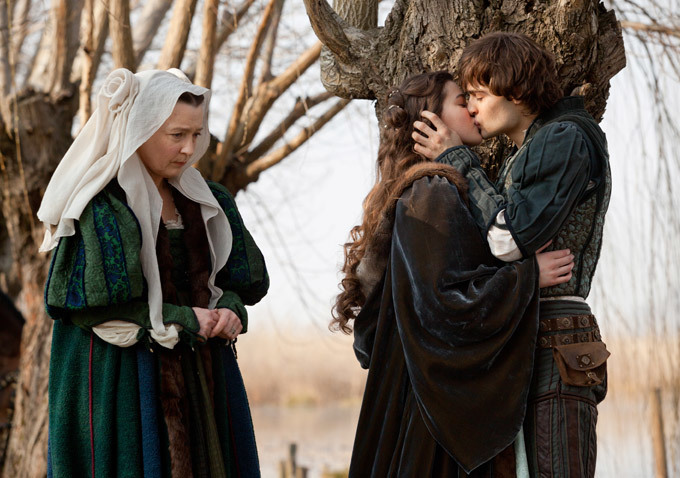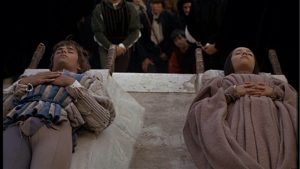“Romeo and Juliet had to die; do you understand that?”
My friends and I, sitting in our Ninth Grade Honor’s English class, were flabbergasted when we heard Mrs. Feldhausen say this. We drew in our breath in surprise and began to argue with her:

“No, they didn’t! It was just a series of really foolish mistakes that led them to die.”
“Nothing had to happen; it’s a story.”
“Shakespeare could have written the story however he wanted.”
Our teacher patiently listened to each of our objections; and, when we had quieted down, she began to speak.
“The love that is represented in this play is a love that must die. So if Shakespeare had not killed the two characters experiencing that love, he would have had to kill the relationship in some way.”
“What?!” we cried.
“Their love was so true. It should have continued forever.”
“If they had lived, they would have had a wonderful life together.”
“True love never dies!”
Mrs. Feldhausen continued to explain that she was referring to a specific kind of relationship – the vibrant, edgy, hormonally-charged connection that occurs at the beginning of many young love affairs – and that that does not survive. It dies.
Being vibrant, edgy, hormonally-charged 14 and 15 year olds, we knew that she was wrong. She must never have been in love, we surmised; and, besides, she was just entirely out of touch with Romeo and Juliet – and with us. What could she possibly know about young love? She must have been at least 40!
At the time, I did not believe Mrs. Feldhausen, but our discussion about Romeo and Juliet planted a seed for me, a seed that has continued to grow into a blossoming awareness of life’s little deaths. I have returned to that day during my Ninth Grade year many times as I contemplate metaphysical and metaphoric deaths.
A recap, for those of us who never read the play or have forgotten its plot: boy meets girl; boy and girl fall in love; boy’s family and girl’s family have generations-old feud;

boy and girl vow to be together, regardless of the fact that their families will not allow it; boy and girl secretly marry; girl’s family secures her engagement to another boy; girl follows advice from spiritual advisor to take a potion that will make her appear dead, thereby escaping marriage to other boy and making it possible to run away with boy; boy sees her and thinks she is actually dead; boy kills himself; girl wakesup and kills herself. (for a more complete summary, jump over to Spark Notes)
The story is not Shakespeare’s invention; there are several previous versions. Indeed, it may reflect an actual occurrence in Verona in 1303.
Regardless of its factual authenticity, however, Romeo and Juliet is true. It is true in its reflection of human nature and in what it has to teach us. We learn that family feuds destroy the lives of everyone involved. We learn that clear, consistent communication is vital in a relationship. We learn that slow mail delivery can cause large problems.
And of course we learn about death – not just about physical death. It turns out Mrs. Feldhausen was right; Romeo and Juliet’s young love, that phase in their lives, had to die. Can you imagine them decades later, raising children and negotiating household responsibilities, navigating aging bodies and the forgetfulness of later years? No, because those young people never made it there; they never would have made it there – at least not in this form. It’s not that their young love never existed or existed on some higher plane than other love. It is not that young love is false or not as strong as the love shared between older persons. Nor is it that young love is truer and stronger than that experienced later in life.
It is just that that phase of their relationship had to die. It happens to all of us, multiple times throughout our lives and throughout the years of long relationships. Shakespeare doesn’t allow them to live into middle age or old age, because even if they did, that specific kind of love, that way of relating would not live. Lots of Romeos and Juliets lived. They live today. But that unique time of young love – with the fuel of hormones and illicit meetings — that doesn’t live on forever. 
And its death is just one of a multitude of little deaths we encounter throughout our lifetimes. If we live long enough we will experience a variety of deaths: deaths of relationships, of jobs, of communities, of living situations, of vibrancy and vitality as we age, of concepts of self, of identifications that have shaped us.
Sages from all times and every portion of the globe have advised us to practice for death. Mohammed said we must “die before we die”, and Jesus taught us to “give up our lives to save them”. What do these things mean? Why would we want to practice for our own deaths?
Medieval Christian monks would whisper in one another’s ears, “Remember: you will die”. And contemporary Buddhist practitioners spend hours on their meditation cushions experiencing death in their healthy bodies. So how can we do the same thing; how can we practice dying?
Contemplating Romeo and Juliet is a good place to start, as is connecting with the Romeo or Juliet we used to be.
Death is not merely one final happening in a lifetime; it is not the finish line that we are forced toward as we take our final breaths. Rather, all deaths are integral to our life – both our final, physical deaths and all the smaller deaths we experience on the way to that last event. And we can use those smaller deaths both to help ourselves prepare for our physical dying and to help us live each of our days more abundantly. Without allowing ourselves repeatedly to die throughout our lives, we likely will find ourselves struggling against death as our physical bodies decline. We will resist the natural flow of life in our attempt to keep living, so that ultimately our obsession with living robs us of our ability to live fully.
This was true for me. I found myself thrust into the realm of little deaths the first time I was dying. What I realized then was that I had never learned how to die; I had never learned to surrender to even the tiniest deaths in my life. With each of my many moves throughout childhood and my young adult years, I had focused my attention and energy on my new home rather than the one I was leaving (often months before I had even relocated). When a relationship ended, it was quickly replaced with a new one. My awareness was always trained on the future, rather than on what was passing out of my life in the moment.
As I struggled to learn how to die, I began to dream of all those deaths. My days and nights were filled with images and memories of times, places, and people that had filled my world and had somehow been left. And one of those memories was of that day in Mrs. Feldhausen’s class. Suddenly, her wisdom became clear.
Romeo and Juliet did have to die, just as those phases, situations, and relationships of my earlier years had to die.
But I had never grieved those endings. I had never learned how to surrender to any of those little deaths in my life. And I knew that I needed to start, because I had a whole treasure chest filled with unacknowledged losses; and it was causing me anguish as I tried to learn how to die.
Here’s a secret I rarely share, because it’s one that many of us cannot comprehend: sometimes those “little deaths” have been more challenging for me than my three walks with physical death. The most difficult aspect of dying is allowing ourselves to die, surrendering to the death that is occurring already. And in my experience it can be even more challenging in metaphysical and metaphoric deaths. Each time my body has been dying, I have been unable to hide that reality from myself and others for any period of time. My body then actually supports my dying process. Amazingly, those of us who are dying physically actually may have an advantage over those who inhabit healthy bodies, because our physical forms themselves aid in the process of surrender.
Surrender is a kind of muscle that we can work. But few of us take the opportunities to work that muscle that are presented to us every day. And I promise, the more we work at surrender, the less we have to surrender when our final death eventually arrives.
So how can Romeo and Juliet teach us about surrender? Can these young lovers guide us through our little deaths so that we are better prepared for our final surrenders?
Let’s imagine a modern-day Romeo and Juliet. Their relationship ends in one of the usual ways that young love ends today – a snarky text message or something unkind posted on social media; another cute boy or girl enters the picture or parents deny access to one another. Thankfully, no physical deaths occur; but there is a significant death, one that needs to be grieved. Rather than Romeo hanging out at the bars or Juliet posting an ad on an internet dating site to replace one another, each honors the end of the relationship. They acknowledge this death and surrender to the grief it brings. And, eventually, they are able to open to new relationships without carrying the disowned sorrow deep in their psyches.
Or maybe our contemporary Romeo and Juliet stay in their relationship. They grow up together; they even grow old together. And they choose to honor the passing phases of their lifetimes in ways that allow them to surrender and grieve. They use each little death – the death of his hearing, the death of her career, deaths of friendships and homes and treasured objects – to practice for their eventual physical deaths.
As a hospice worker, I have companioned dozens of people through their physical journeys with death. And, as a Spiritual Director, I have also companioned dozens of people through these “little deaths”. And I promise – those little ones are of great benefit when we arrive at the final death of our life.

So, if I were Spiritual Director for either Romeo or Juliet, I would hope to do a better job than Friar Lawrence did. Once their relationship had ended, there would be a funeral – but not of the variety that we have in the play. Rather I would lead the young lover through a ceremony to honor the relationship that had passed; I would support the grief that is vital to healing.
Scholars have long argued about placing this play within Shakespeare’s canon of true tragedies; many contend that the main characters do not have fatal flaws – a necessary component in tragedy (for a commentary on the play that is equally enlightening and entertaining, see Thug Notes).
Hamlet’s indecisiveness, Macbeth’s ambition, King Lear’s pride – all fatal flaws that bring about total destruction. Romeo and Juliet don’t have flaws like that; maybe they would have had they aged into adulthood.
The fatal flaw they have is one we all share: they are humans who suffer many little deaths on the path to their final physical death. Like us, they had to die. Like them, the teenager I was who raged against this notion also had to die.
My children have both now also studied Romeo and Juliet in their Ninth Grade Honor’s English classes. And I have suggested Mrs. Feldhausen’s theory to them. Neither one really connects with it. My daughter thinks I’m totally out of touch and unromantic when I talk about such matters. And my son contends that the only thing he learned from those star-crossed lovers is that “Shakespeare wrote some bad plays as well as good ones.”
I have no doubt that their opinions will change as they grow. I also have no doubt that this growth will necessitate some little deaths, ones I hope they acknowledge and honor . . . just as I hope you acknowledge and honor each of the little deaths in your life.